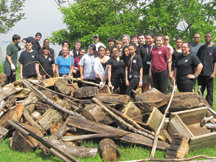“Get some gloves and pick a partner,” Tom Tokar yelled, standing on the water-sodden lawn near Ahern Stadium in a small curve along Newark Bay.
Students from Bayonne High School grabbed a pair of white gloves left in a pile on the lawn, then marched down a narrow path to a 60-yard-long beach, which rain and high tides have littered with an assortment of debris, from giant logs to soggy toys. Plastic bottles decorate the dry reeds like Christmas ornaments, hundreds of bottles in every shape and color, all of which have floated down from the mouths of the Passaic or Hackensack rivers from places far up in Bergen and Passaic counties.
This is one of two cleanups where Bayonne students, as part of an educational program on the environment, teamed up with the Passaic Valley Sewerage Commission, which supplies the gloves, bags, and other items. The commission also disposes of the waste collected.
“After we did the clean up a few months ago, we saw how clean the water was and we saw a lot of birds.” – Wendy Herrera
____________
Tokar has been reaching in Bayonne for more than 25 years, is the son a refinery worker, and began his own greening of his hometown in the early 1990s when he began planting thousands of trees throughout the city.
Overall, however, this is the 15th year in which students have played an active role in environmental cleanup with the Bayonne Cleaner and Greener program, which was started by a Bayonne science teacher, Anna Panayiotou.
The goal of “Cleaner and Greener” is to empower residents to make Bayonne a model urban community where trees, flowers, shrubs, and natural wildlife can flourish without risk, and the community can remain clean and free of pollution.
This year, students from Bayonne High School and Lincoln Community elementary school joined staff members from the PVSC’s River Restoration Program to clean up a beach that historically becomes a magnet for trash washing ashore during storms and high tide.
Tokar, the head of the “Bayonne: Cleaner and Greener” program, said the program allows students to engage the environment personally beyond just their education, and to get a sense of accomplishment from the experience.
“We’re trying to promote awareness, as well as clear the beach,” he said.
Although Wendy Herrera is only a freshman at Bayonne High School, she has already had experience with these projects. She was part of a group of students who did a similar cleanup earlier this school year, and was involved in the cleanup last year when she was an eighth grader at John M. Bailey Elementary School.
“After we did the clean up a few months ago, we saw how clean the water was and we saw a lot of birds,” she said. “A little while after that, we saw a baby seal come around. I was very excited about that.”
While she isn’t planning to pursue a career in anything related to environmental science, she said she is interested in the environment and will continue to be involved.
David Minardi, director of technology and science for the Bayonne School District, stood on the shore watching the kids work, saying that he is amazed at how much clearer the water is than when he grew up here.
“When I was younger, the water here was black,” he said.
This was due in large part from activity that went on upstream, and the misguided notion of manufacturers who used the river to dispose of waste, something that has changed over the years.
He said that before that, when his grandparents grew up in Bayonne, these shores – especially areas near where 16th Street Park is located now and the lower portion of the Stephen Gregg County Park between 37th and 39th streets – were places with beaches like the one being cleaned up.
“My grandparents swam in the bay,” he said.
He said the idea of clean up programs like this one is to get the kids involved in the environment, giving them a hands-on lesson that they could never get in the classroom. Here, they get to see the waste and the difference the cleanup makes, and even if it gets dirty again, these students actually see that what they did made a difference.
Al Sullivan may be reached at asullivan@hudsonreporter.com.
